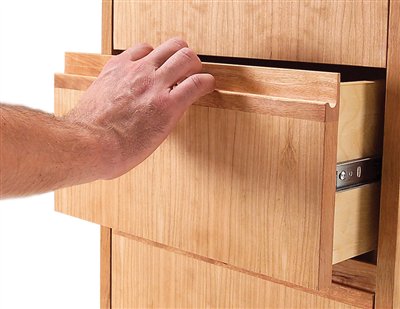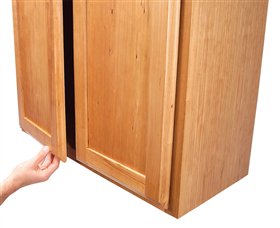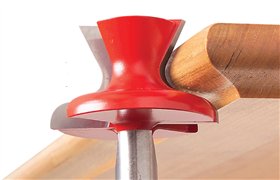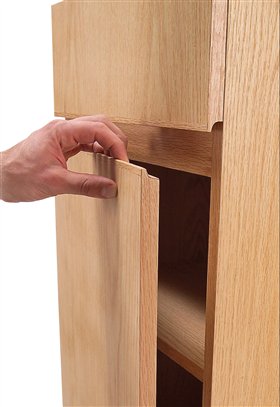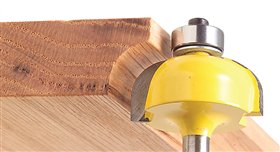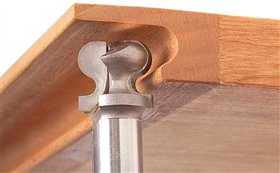We may receive a commission when you use our affiliate links. However, this does not impact our recommendations.
Router-Made Drawer and Door Pulls
If you’re after a sleek, clean look, a wooden pull that’s an integral part of a door or drawer front is
a great solution.
By Brad Holder
You can make integrated pulls yourself using a router table and a few bits. They can be decorative or almost completely hidden. Of the four designs I’ll describe for you, two require special bits, but two use ordinary bits that you may already own.
Finger-Pull Door Lip
|
These doors have a roundover on the back and a decorative cove on the front. The roundover on the back creates just enough room for your fingers to catch hold of the door. This decorative edge treatment around the entire door complements a frame-and-panel style quite nicely. Use European-style hinges and you’ll have no visible hardware. |
Click any image to view a larger version. |
|
The Bit: Specifically designed for creating pulls, this router bit has no bearing and is quite large with a diameter of 1-3/4 in. Use the bit in a router table and take three or four passes. The door shown is 3/4-in. thick, but this bit will work on doors as thick as 1-1/4 in. Be sure to test the bit on scrap pieces of wood of the same species you’re working with and to experiment with different speeds. Some species will chip or splinter at one speed but may work well at a different speed.
Source Freud Tools, freudtools.com, 800-472-7307, Finger-pull door-lip bit, #FRD 99-065. |
Hidden Cove
|
This hidden pull is made by an ordinary cove bit. It works well on solid wood, fibercore or plywood. On fibercore and plywood, first add a 1/8-in. to 1/4-in. solid-wood edge to the panel’s edges and then rout the cove. Some core will be exposed after routing, but it will be hidden after the door is installed. |
|
The Bit: For this cabinet, I used a 1/2-in. cove bit with a bottom bearing. This bit works equally well in a handheld router or a router table. Leave about a 1/4-in. flat lip on the front of the panel.
Source Oldham, 888-678-7278, 1/2-in. cove bit, #3164COV. |
Dovetail Bevel
|
This visible decorative pull is made using an ordinary dovetail bit. The entire length of the door’s inner edge can be used as a pull. I used a shop-made template as a guide to create a circular design in the middle to complement the cabinet’s modern look. The Setup: Use a router with a guide bushing to follow the template. The template can be made in whatever shape you choose. |
|
The Bit: This 3/4-in.-dia. dovetail bit has a 14-degree angle that leaves an easy-to-grip edge. On these 3/4-in.-thick doors, I set the bit to cut 1/2 in. deep. Any deeper than this would weaken the door’s revealed back edge.
Source Freud Tools, freudtools.com, 800-472-7307, |
Finger Grip
|
This visible decorative pull is made by a specialty bit. The shape is routed into an applied solid-wood edging. Use stock at least 1-1/2 in. wide. This will result in a nearly 1-in. space for your fingers. You can make it wider if you like, so run a couple of test cuts to figure out how much space is comfortable for you. You don’t want to end up scraping your knuckles every time you open the drawer. |
|
The Bit: This bit is designed specifically for creating pulls. The bit has a 3/4-in.-dia. cutter and a 1/2-in. shank. You can use it in a router table or a handheld router. It leaves a smooth, rounded-over front edge, which is easy for your fingers to grip. This bit removes a lot of wood, so make the cut in several light passes, especially as you get closer to your final dimension. It’s a real drag to hear a big splinter pop out on the “final” pass. Another option is to first remove the majority of waste with a dado blade on your tablesaw.
Source Amana Tool, amanatool.com, 800-445-0077, Drawer-pull door-lip bit, #53806. |
|
This story originally appeared in American Woodworker January 2006, issue #119. |
|
Here are some supplies and tools we find essential in our everyday work around the shop. We may receive a commission from sales referred by our links; however, we have carefully selected these products for their usefulness and quality.



